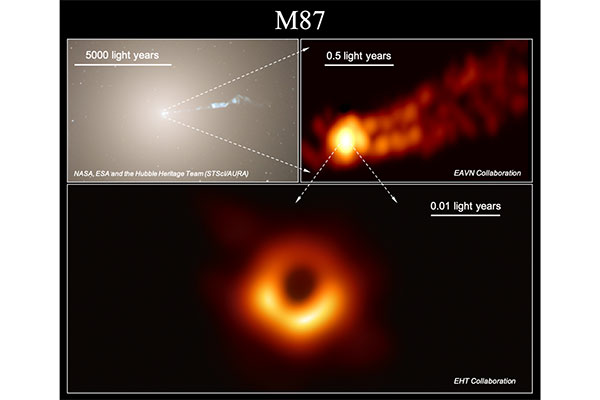The Event Horizon Telescope (EHT) collaboration astounded the world on April 10, 2019, when it released the first-ever image of a black hole that sits at the centre of the M87 galaxy.
Today, the same project has revealed a new view of the black hole that displays how it looks in polarized light, offering astronomers the first chance to measure polarization--a signature of magnetic fields--this close to the edge of a black hole.
"This is a key to explaining how the M87 galaxy, located 55 million light-years away, is able to launch energetic jets from its core," said associate professor Kenji Toma from Tohoku University's Frontier Institute for Interdisciplinary Research and a participant in the EHT collaboration's Computation Group.
Observing the heart of the M87 galaxy required linking eight telescopes around the world to create a virtual Earth-sized telescope. The resolution is capable of measuring the length of a credit card on the surface of the moon.

Harnessing this technology, the EHT collaboration directly observed the black hole shadow and the ring of light around it, with the new polarized-light image clearly showing that the ring is magnetized.
Light becomes polarized when it goes through certain filters, like the lenses of polarized sunglasses, or when it is emitted in hot, magnetized regions of space. Specifically, polarization allows astronomers to map the magnetic field lines at the inner edge of the black hole.
Most matter lying near the edge of a black hole falls in. However, some surrounding particles escape moments before capture and are blown far out into space in the form of jets. Astronomers had relied on different models to understand this process, but explanations as to how jets larger than the galaxy get launched from its central region remained elusive.
"The newly published polarized images are key to understanding how the magnetic field allows the black hole to 'eat' matter and launch powerful jets," says Yosuke Mizuno, coordinator of the EHT Theoretical Models and Simulations Working Group and T.D. Lee fellow at Tsung-Dao Lee Institute & School of Physics and Astronomy of Shanghai, Jiao Tong University in China.
Theoretical analysis found it most probable that spiral magnetic fields that thread the black hole become strong enough to push back on the gas against gravity's pull, regulating the gas fall and the jet ejection.
"The observations finally confirm the innermost structure of magnetic fields that strongly support the standard model of the magnetohydrodynamic jet. We expect further investigation together with multi-wavelength radio observations to reveal more about the black hole spin constraints," says Masanori Nakamura, an EHT collaboration member and associate professor at the National Institute of Technology, Hachinohe College, who has been studying the M87 jet for over ten years.
The EHT collaboration published the results of the study with two separate papers in The Astrophysical Journal Letters. The research involved over 300 researchers from multiple organisations and universities worldwide.
- Publication Details:
First M87 Event Horizon Telescope Results VII: polarization of the ring
Authors: The Event Horizon Telescope Collaboration
Journal: The Astrophysical Journal Letters
DOI: https://doi.org/10.3847/2041-8213/abe71dFirst M87 Event Horizon Telescope Results VIII: Magnetic Field Structure Near The Event Horizon
Authors: The Event Horizon Telescope Collaboration
Journal: The Astrophysical Journal Letters
DOI: https://doi.org/10.3847/2041-8213/abe4deRelated to this result, a paper of analyzing the observation data with ALMA alone is published at the same time as the above two papers.
"Polarimetric properties of Event Horizon Telescope targets from ALMA"
DOI: https://doi.org/10.3847/2041-8213/abee6a
Contact:
Kenji TOMA
Frontier Research Institute for Interdisciplinary Sciences
Email: toma fris.tohoku.ac.jp
fris.tohoku.ac.jp
Website: https://www.fris.tohoku.ac.jp/en/


